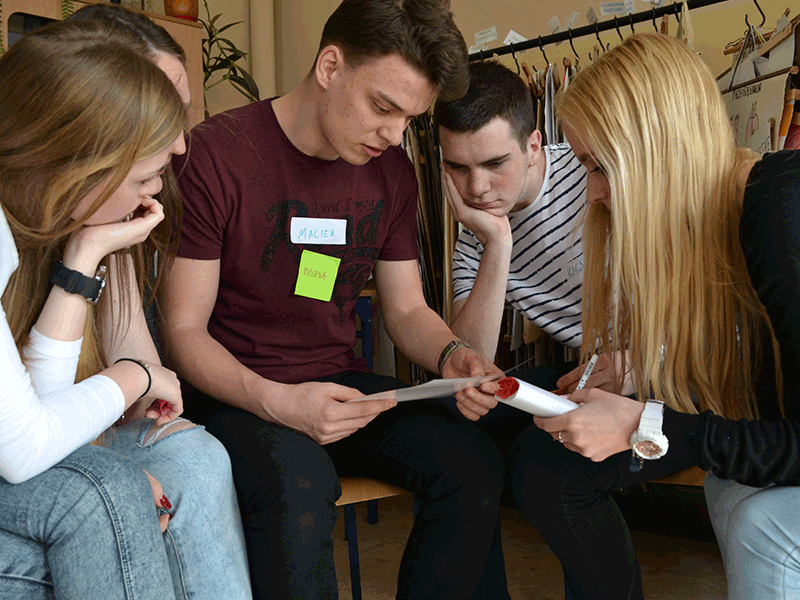Students researching Jewish history in Polish towns learned of two unmarked sites where Jews were executed during the Holocaust, causing the teenagers to petition local authorities to install commemorative plaques there.
The students were participants in Polish-Jewish education workshops offered at their schools through the Warsaw-based School of Dialogue program. One site of genocide was located in Sosnowiec, a city in southern Poland, and the other in Bircza, a village in the southeastern part of the country, said Marta Usiekniewicz, a communications assistant with the Forum for Dialogue, which oversees the school program.
She said a group of 15-year-old junior high students from Sosnowiec, where 30,000 Jews lived before the Second World War, learned of an unmarked execution site next to another school’s sports field. Jews were murdered there in May 1944, after Sosnowiec’s Srodula Ghetto was liquidated.
In a 2016 video, one student, Martyna, says in Polish, “We had no idea so many Jews lived in Sosnowiec. We wanted to commemorate it. There was no mark, no plaque, nothing mentioning Jews.”
Then Igor says, “We want the residents of Sosnowiec to know about it because it is an important part of our town’s history. We have a school historical society. They told us to ask the local authorities. We submitted a request to the local authorities and they said, ‘Of course. Why not?’”
READ: UP CLOSE AND PERSONAL WITH POLAND’S JEWISH REVIVAL
In Bircza, a 17-year-old who was part of a School of Dialogue program learned of an unmarked place in the woods where 800 Jews were executed. A memorial plaque was installed there, as a result of the students’ initiative. In a trailer for the 2015 documentary, 800 Jews from Our Town, we hear the students speaking as they walk through the woods. “Eight hundred seems to me a bit exaggerated. What do you think, Michal?” a young woman asks in Polish.
“No, I think it’s an accurate number,” he replies.
“The lady said the Jews were led that way, through this bridge, which used to be wooden,” Michal continues.
Then a witness, an elderly woman, confirms: “That was the way they were led. And I stood exactly in that place.”
Since 2008, around 8,000 high school and junior high school students from 300 schools in 200 cities, towns and villages in Poland have participated in School of Dialogue workshops, which introduce them to Jewish history, tradition and religion, and send them out to research Jewish sites in their communities.
The School of Dialogue focuses on smaller Polish communities that had a significant Jewish population before the Second World War, as studies have shown that anti-Semitic attitudes are higher outside large urban centres like Warsaw, Usiekniewicz said.
Before participating in the program, the students may have walked past synagogues, mikvahs and cheders in their towns many times, thinking of them as ordinary buildings. Through research, the teenagers reveal their Jewish connections.
“We want them to know the local history, to know about local Jews who lived in their town and to understand that when they learn about the Holocaust, it’s not just Auschwitz or Treblinka or Warsaw Ghetto, but that there was a ghetto in their town, there was a concentration camp,” she said.
The student’s research may include interviewing older people in the community, among them grandparents who remember the prewar past. “Those people who remember prewar Poland are at a time in their lives when they’re willing to share memories that may be hard,” Usiekniewicz said.
Once the research is done, students take local residents, and sometimes descendants of Jews who lived in their town, on tours of the Jewish sites. The students become custodians of Jewish memory in their town, she said.
These young people have grown up in a mono-religious, mono-ethnic culture, Usiekniewicz said. “When they discover prewar local history, they discover a world that is multi-ethnic, which is hard for them to experience now. It’s amazing when they discover that there was this entire other culture in their towns.”
Two of the students have come across information about their own families that was new to them. One of the program’s participants learned that her family has Jewish roots and another found out that his grandparents were awarded the Righteous Among the Nations title.
At the end of the program, the teenagers often wonder why no one had told them before about the Jews who had lived in their communities before the Second World War. “Once they learn these things, they also start to feel responsible for commemoration and for the preservation of Jewish heritage in their town,” Usiekniewicz said. “What they also see is that there is not a lot of commemoration of Jewish sites and it is their task to make it happen.”
Local Polish activists like Zbigniew Wieczorek, a schoolteacher from Radom, are also involved in commemoration. As an activist who is part of the forum’s Leaders of Dialogue network, Wieczorek had tried for years to commemorate Radom’s Jewish community.
In 2015, Wieczorek met two Americans, Hilda Chazanovitz and Sharon Grosfeld, who are both daughters of Holocaust survivors from Radom. That led to a Passover seder in Radom in 2016, and then the three of them worked toward the creation of a trail of plaques commemorating the town’s Jewish past.
The Jewish Memorial Route in Radom was unveiled last month, during The Trace, an annual event in Radom that features Jewish culture and focuses on the history of the city’s Jews. This year, The Trace commemorated the 75th anniversary of the liquidation of the Radom Ghetto.
The memorial route “would not have happened if not for the success of the seder, which showed the local authorities how important such a permanent commemoration of Radom’s Jewish past is,” Usiekniewicz said.
For more information about the Forum for Dialogue, visit dialog.org.pl.
